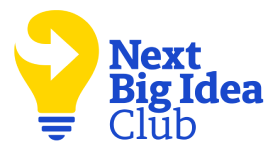Julia Austin has spent her career as a startup operator, executive coach, educator, investor, and board member. She is on the faculty at Harvard Business School and is faculty co-chair of the Arthur Rock Center for Entrepreneurship.
What’s the big idea?
After the Idea is a field manual to help you see around corners when founding or joining a startup: to understand what’s coming up next and not feel alone when things get hard. Startup life is messy, beautiful, overwhelming, and oftentimes rewarding. This guide provides a toolkit for navigating the complex reality of moving from a great idea to a functioning business with clarity and confidence.
Below, Julia shares five key insights from her new book, After the Idea: What It Really Takes to Create and Scale a Startup. Listen to the audio version—read by Julia herself—below, or in the Next Big Idea App.

1. The real work starts after the idea.
The journey from idea to company is rarely linear—and almost never glamorous. Most founders have an OMG moment early on in which they realize that they are not just building a product, fundraising, and selling: they are building a company.
In the early stages of a startup, focus tends to be on the immediate needs around creating a product rather than on a more holistic view of what the business may look like months or years from now. It can be easier to focus on what’s right in front of you when the big picture can be a daunting, or even paralyzing, concept.
Founders are often portrayed to the outside world as “crushing it,” but internally, they may be filled with doubt, imposter syndrome, and fear. They can be plagued by thoughts like, Does my idea suck and no one is telling me? Do I know anything about running a business or leading a team?
If every company founder could go back in time and rethink their startup plan, most would say they wished they had been more intentional about the operations of their business. It is never too early to be thoughtful about team culture and hiring, brand image, finances, legal considerations, and everything else beyond the product or service on offer.
Most teams fail to get these tactics right at the start of a new venture, and not everyone has a coach or professor to show them the way. After the Idea is about the nuts and bolts of startups beyond just the product. It’s about building something that works after the excitement fades and the real challenges kick in.
2. Move slow to go fast.
Everyone loves the myth of overnight success. In startup culture, we’re told to move fast, break things, and launch quickly. But moving too fast before you understand the problems can waste months (potentially years) and a lot of money.
I teach my students and clients to move slow to go fast. That means taking time early on to understand the customer—who they are, what they need, what they struggle with, and how they make decisions—through proper discovery work. Discovery goes beyond customer interviews. Thorough discovery involves observing your target audience in their natural environments and conducting experiments to better understand the problem you are solving. These techniques allow you to validate and invalidate assumptions to become more confident about what to build—and what to ignore.
“Discovery goes beyond customer interviews.”
In 2018, the founding team of Brij began with an idea to help consumers track valuable items—like laptops or jackets—using QR codes. The concept was a kind of digital insurance, helping lost items find their way back to their owners.
Before building anything, they conducted real-world experiments by leaving tagged items in public places to observe how passersby responded. Through this, they learned what people valued and how likely others were to return certain items—a water bottle, not so much; a laptop, yes.
More importantly, they realized the real opportunity wasn’t in lost-and-found services, but in using QR codes as a marketing tool for consumer brands. That insight led them to pivot before hiring a team or building infrastructure for a business they didn’t want to run. Their discovery work clarified the business they truly wanted to build.
Just like checking the weather before a hike, discovery work doesn’t give you every detail, but it helps you get oriented before heading into the unknown. What you learn won’t just shape your product, it will influence the business you build, the roles you hire for, how you sell, and how you operate. Discovery is the foundation. It’s one of the smartest investments to make at the start of a startup journey.
3. The universal challenges founders face.
There are many types of founder stories. Founders come from all walks of life—women and men, people of color, from around the globe—building everything from enterprise software to food products to mission-driven consumer brands. No matter how different their businesses were, their challenges were strikingly similar.
Every founder must wrestle with hiring the right people—often while competing with better-funded companies or trying to convince others to join something that barely exists. Building a team isn’t just about finding talent; it’s about aligning on values, communicating clearly, and building trust under pressure.
Then, there’s managing cash—something that can make or break a startup. Founders have to make tough trade-offs: Do we invest in growth or extend runway? Can we afford this hire now, or do we wait? Raising capital, budgeting, forecasting, and understanding burn rate become daily concerns.
“Building a team isn’t just about finding talent; it’s about aligning on values, communicating clearly, and building trust under pressure.”
Legal complexity is another constant. Early decisions—like how to incorporate, how to split equity, or whether your IP should be protected—can have ripple effects years down the line. Many founders don’t realize they’re setting the foundation for future funding rounds, partnerships, or even exit scenarios.
Through it all, there are difficult conversations. With co-founders when visions diverge. With investors when goals aren’t being met. With customers when promises fall short. Add to that the emotional rollercoaster of building something from nothing and it’s no surprise founders often feel isolated or overwhelmed.
For anyone trying to turn an idea into a real, functioning business, while the industries may differ, the patterns—the messy, high-stakes, emotional work of building something from scratch—are surprisingly universal.
4. The emotional side of startups.
Founders are constantly managing pressure—from investors, from customers, from themselves. If you have co-founders, the interpersonal dynamics can get intense fast. I’ve seen many startups unravel, not because of product issues, but because the human side wasn’t managed well, resulting in burnout, resentment, misalignment, or a lack of trust.
The number one statement my coaching clients say when we start a session is, “I am so overwhelmed.” Starting or joining a new venture can be an exhilarating experience, but it can also be incredibly demanding and stressful. When jumping onto this rollercoaster, it’s crucial to be aware of the potential impact on your mental health and take proactive steps to safeguard your well-being. The first step is to be honest with yourself and acknowledge the stress. Admitting to yourself and your cofounder, partner, or coach that you are stressed is a step in the right direction.
Once you acknowledge the stress, take steps to manage it. Whether you’re a founder, early team member, or investor, it’s essential to accept imperfection and embrace uncertainty because both are constants in startup life. Prioritize self-care, set clear boundaries, and protect your personal time (because a startup will take all of it if you let it). Find a supportive community of objective, empathetic ears that you can turn to in times of stress. And consider working with a coach who understands the realities of startup life and can help you navigate and normalize the inevitable challenges.
Building a company isn’t just about strategy; it’s about resilience, relationships, and emotional endurance. The average founder journey for a business that gets off the ground is 7-10 years. The more intentional you are about managing all the feels, the stronger your company will be.
5. Defining success.
Alignment around a shared vision for success and desired outcomes is tantamount to the long-term success of any startup. While everyone wants to jump into product discovery and solution building, alignment on where your startup is heading and what success looks like is pretty darn important.
Early in his startup journey, my student Sam and his co-founder aligned on what they each wanted in terms of financial achievements of the business within a certain time frame, but they didn’t get into their personal outcome scenarios. This is common for many founders. It’s easier to center the success conversation on product growth, types of customers, and revenue. It can be daunting to have vulnerable conversations and tie the success of the business to your personal goals and aspirations. It wasn’t until an acquisition opportunity came up that Sam and his co-founder were faced with the reality that they were not, in fact, aligned. Sam was excited about the financial upside and the opportunity to start working on a new idea; his co-founder, on the other hand, was perfectly happy maintaining a modest business that he had full control over, rather than becoming an employee at someone else’s company.
“Whether you are a founder or a joiner, I encourage you to consider why you are entering Startup Land.”
Getting clarity on why you want to start a new venture is important. Every aspiring entrepreneur or startup joiner I chat with has a different reason for why they want to get on this crazy ride. Some want the autonomy and control that comes from being their own boss (a myth if you take outside capital) or the ability to innovate quickly. Some want to prove themselves to their family and friends, or want to make an impact on the world. However, it’s hard to imagine what that path will look or feel like once a business is off and running or when it’s time to pursue an exit or, for some, throw in the towel because they just can’t get there for any number of reasons.
Whether you are a founder or a joiner, I encourage you to consider why you are entering Startup Land and what success means to you beyond the potential for a big financial outcome. Record your thoughts in some way so you can reflect on this over time, because what success might look like today can change as you mature throughout the journey.
Enjoy our full library of Book Bites—read by the authors!—in the Next Big Idea App:































